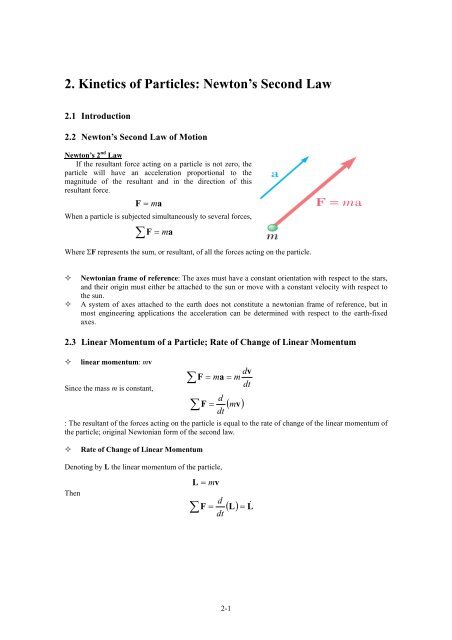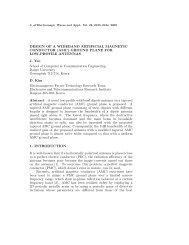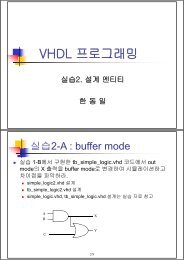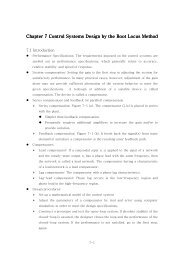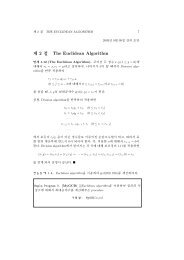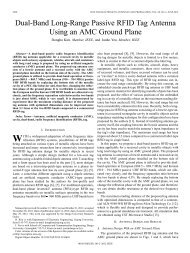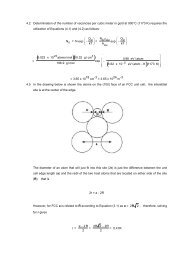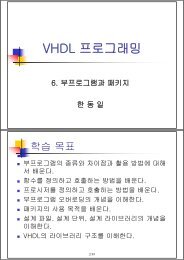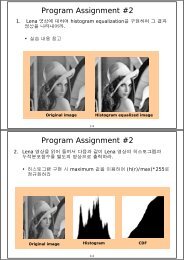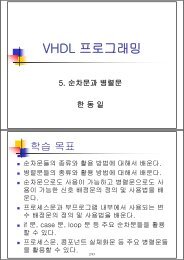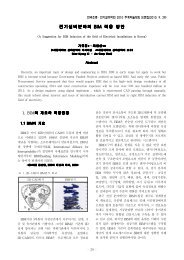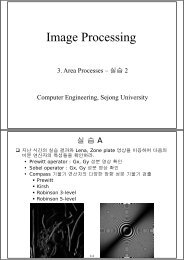2. Kinetics of Particles: Newton's Second Law â â â
2. Kinetics of Particles: Newton's Second Law â â â
2. Kinetics of Particles: Newton's Second Law â â â
- No tags were found...
You also want an ePaper? Increase the reach of your titles
YUMPU automatically turns print PDFs into web optimized ePapers that Google loves.
<strong>2.</strong> <strong>Kinetics</strong> <strong>of</strong> <strong>Particles</strong>: Newton’s <strong>Second</strong> <strong>Law</strong><strong>2.</strong>1 Introduction<strong>2.</strong>2 Newton’s <strong>Second</strong> <strong>Law</strong> <strong>of</strong> MotionNewton’s 2 nd <strong>Law</strong>If the resultant force acting on a particle is not zero, theparticle will have an acceleration proportional to themagnitude <strong>of</strong> the resultant and in the direction <strong>of</strong> thisresultant force.F = maWhen a particle is subjected simultaneously to several forces,∑F = maWhere ΣF represents the sum, or resultant, <strong>of</strong> all the forces acting on the particle.Newtonian frame <strong>of</strong> reference: The axes must have a constant orientation with respect to the stars,and their origin must either be attached to the sun or move with a constant velocity with respect tothe sun.A system <strong>of</strong> axes attached to the earth does not constitute a newtonian frame <strong>of</strong> reference, but inmost engineering applications the acceleration can be determined with respect to the earth-fixedaxes.<strong>2.</strong>3 Linear Momentum <strong>of</strong> a Particle; Rate <strong>of</strong> Change <strong>of</strong> Linear Momentum linear momentum: mvdv∑F = ma= mdtSince the mass m is constant,d∑F = ( mv)dt: The resultant <strong>of</strong> the forces acting on the particle is equal to the rate <strong>of</strong> change <strong>of</strong> the linear momentum <strong>of</strong>the particle; original Newtonian form <strong>of</strong> the second law.Rate <strong>of</strong> Change <strong>of</strong> Linear MomentumDenoting by L the linear momentum <strong>of</strong> the particle,ThenL = mv∑F =ddt( L) = L&2-1
<strong>2.</strong>4 Systems <strong>of</strong> UnitsInternational system <strong>of</strong> Units (SI Units): absolute system <strong>of</strong> units- length: meter (m)- mass: kilogram (kg)- time: second (s)‣ force: newton (N):1N = (1kg) (1m/s 2 ) =1 kg.m/s 2U.S. customary units: gravitational system <strong>of</strong> units- length: foot (ft)- force: pound (lb)- time: second (s)‣ mass: slug1slug = (1 lb) / (1ft/s 2 ) = 1 lb. s 2 /ftConversion from One System <strong>of</strong> Units to Another- Length: 1 ft = 0.3048 m- Force: 1 lb = 4.448 N- Mass: 1slug = 14.59 Kg1 pound-mass = 0.4536 kg<strong>2.</strong>5 Equations <strong>of</strong> Motion Rectangular Components∑∑F =Fx∑dvF = ma= mdt∑( Fxi+ Fyj + Fzk) = ma= m( axi+ ayj + azk)max= mx&∑ Fy= may= my && ∑ Fz= maz=& = mz &&Tangential and Normal Components∑∑F =t∑F = ma =( F e + F e ) = ma= m( a e + a e )tttndvmdtn∑Fn= mantt= m2vρnn2-2
<strong>2.</strong>6 Dynamic equilibriumDynamic equilibrium∑∑F − ma= 0F − mtdvdt= 0∑Fn2v− m = 0ρInertia vector / force (-ma, -mv 2 /ρ): <strong>Particles</strong> <strong>of</strong>fer resistance force when we try to set them inmotion or when we try to change the conditions <strong>of</strong> their motion. Not acting forces; Shadow forcesExample <strong>2.</strong>4)The 12-lb block B starts from rest and slides on the 30-lbwedge A, which is supported by a horizontal surface.Neglecting friction, determine (a) the acceleration <strong>of</strong> the sedge,(b) the acceleration <strong>of</strong> the block relative to the sedge.Ans)Kinematicsa A : horizontal acceleration <strong>of</strong> wedge Ba B : acceleration <strong>of</strong> block Ba B/A : relative acceleration <strong>of</strong> block B to wedge A.a = a + a<strong>Kinetics</strong>We draw the free-body diagrams <strong>of</strong> the wedge and <strong>of</strong> the block and apply Newton’s 2 nd law.BAB AWedge A:∑N1Fx0.5N1= mosin 30=AaA= mAaA( W Ag) a A(1)Block B:∑−WaFBB A∑Fx= msin 30= ay( a )o WBN −WBcos30 = −ga. Acceleration <strong>of</strong> wedge A:N 1 in (1) (3)a A= 5.07ft sA= mBoW=gcos30Bb. Acceleration <strong>of</strong> Block B relative to wedge A:a A (2)2a B A= 20.5ft sBxo( a )BBaAcos30+ g sin 301 Ay2aooW−gsin 30oBaB A(2)(3)2-3
Example <strong>2.</strong>5)The bob <strong>of</strong> a 2-m pendulum describes an arc <strong>of</strong> circle in a vertical plane. If the tension in the cord is <strong>2.</strong>5times the weight <strong>of</strong> the bob for the position shown, find the velocity and the acceleration <strong>of</strong> the bob in thatposition.HomeworkProblems 1<strong>2.</strong>10, 1<strong>2.</strong>15, 1<strong>2.</strong>16, 1<strong>2.</strong>20,1<strong>2.</strong>45, 1<strong>2.</strong>53, 1<strong>2.</strong>59Ans)a n : acceleration <strong>of</strong> the bob toward Oa t : acceleration <strong>of</strong> the bob perpendicular to an and toward left.∑mg sin 30a<strong>2.</strong>5mg− mg cos30avt∑n2F = mat= g sin 30Fn = ma= 16.03= ρanot= manot= 4.92( m s )= ± 5.66o2( m s )= ma2v=ρ( m / s)n<strong>2.</strong>7 Angular Momentum <strong>of</strong> a Particle; Rate <strong>of</strong> Change <strong>of</strong> Angular MomentumFigure 1<strong>2.</strong>12 Angular Momentum (moment <strong>of</strong> momentum): The moment about O <strong>of</strong> the vector mv, H O :H O= r × mvNote that H O is a vector perpendicular to the plane containing r and mv and <strong>of</strong> magnitudeH O= rmvsinφWhere φ is the angle between r and mv.The unit <strong>of</strong> angular momentum is in SI units2-4
Thus∑( & 2&− rθ) F = m( r && θ + r&& θ )F r= m r ∑ θ2<strong>2.</strong>9 Motion under a Central Force: Conservation <strong>of</strong> Angular MomentumFig. 1<strong>2.</strong>13 ~1<strong>2.</strong>15When the only force acting on a particle P is a force F directed toward or away from a fixed point O, theparticle is said to be moving under a central force, and the point O is referred to as the center <strong>of</strong> force.Since the line <strong>of</strong> action <strong>of</strong> F passes through O, we must have ∑M= 0 at any given instant.OThereforeH &O= 0H = constantO: The angular momentum <strong>of</strong> a particle moving under a central force is constant, in both magnitude anddirection. Recalling the definition <strong>of</strong> the angular momentum,r × mv = HO= constant: Thus, a particle under central force moves in a fixed plane perpendicular to H O .Areal Velocity:H O= mr 2 θ &2-6
Recalling2H = mr &Oθ = constant2r & θ = h = constantwhere h is the angular momentum per unit mass. In Fig.1<strong>2.</strong>15dA =dAdt=12122r dθr2dθdtwhere r is assumed constant during dt. Thus, when aparticle moves under a central force, its areal velocity isconstant.<strong>2.</strong>10 Newton’s <strong>Law</strong> <strong>of</strong> GravitationFig. 1<strong>2.</strong>16In his law <strong>of</strong> universal gravitation, Newton states that two particles <strong>of</strong> masses M and m at a distance rfrom each other attract each other with equal and opposite forces F and –F directed along the line joiningthe particles. The common magnitude F <strong>of</strong> the two forces isMmF = G2rwhere G is a universal constant, called the constant <strong>of</strong> gravitation <strong>of</strong>( )2−123G = 66.73 ± 0.03 × 10 m kg.sSince the force exerted by the earth on a body <strong>of</strong> mass m located on or near its surface is defined as theweight W <strong>of</strong> the body,MmW = mg = G2RMg = G2Rwhere M is the mass <strong>of</strong> the earth and R the radius <strong>of</strong> the earth.2-7
Example <strong>2.</strong>7) A block B <strong>of</strong> mass m can slide freely on a frictionless arm OA which rotates in a horizontalplane at a constant rate . Knowing that B is released at a distance r 0 from O, express as a function <strong>of</strong>0r, (a) the component v r <strong>of</strong> the velocity B along OA, (b) the magnitude <strong>of</strong> the horizontal force F exerted onB by the arm OA.Ans)Equations <strong>of</strong> Motion:(a) Component v r <strong>of</strong> Velocity:∑∑FFrθ= mar= maθθ & ( )& 20 = m && r − rθF = m r( && θ + 2r&& θ )(1)(2)vr= r&dvrdvrdr dvr&& r = v&r= = = vrdt dr dt drSubstituting for & r& in (1), recalling that & θ = & θ , and separating the variables,2&& r = r & θv2r(b) Horizontal Force Fdvr2vr= r & θOdr2vrdvr= r & θOdrv = & θr= & θO2O2 2( r − r )r2O− r2OOEq. (2) yields& θ = & θO&& θ = 0r & = vr2 2 22mOr − rOF = & θ2-8
HomeworkProblems 1<strong>2.</strong>66, 1<strong>2.</strong>72, 1<strong>2.</strong>86, 1<strong>2.</strong>891.11 Trajectory <strong>of</strong> a Particle under a Central ForceConsider a particle P moving under a central force F.The governing equations <strong>of</strong> motion areEq. (<strong>2.</strong>32) is replaced by the expressionwhich leads toThen− F =0 = m r( & 2m && r − rθ)( && θ + 2r&& θ )2 dθr = hdtdθ=dtr&=drdth&& r = −rh2rdr dθh= =2dθdt rdr&dr&dθh&& r = = =2dt dθdt r222d2dθ⎛ 1 ⎞⎜ ⎟⎝ r ⎠dr d ⎛ 1 ⎞= −h⎜ ⎟dθdθ⎝ r ⎠dr&h=2dθrd ⎡ d ⎛ 1 ⎞⎤⎢−h ⎜ ⎟dθ⎥⎣ dθ⎝ r ⎠⎦(<strong>2.</strong>31)(<strong>2.</strong>32)(<strong>2.</strong>34)(<strong>2.</strong>36)Substituting for θ and & r&u = 1/r, we obtain&& r = −−FmFmfrom (<strong>2.</strong>34) and (<strong>2.</strong>36), respectively, in Eq. (<strong>2.</strong>31) and introducing the function+ r & θF 2 3 2− + h u = −hum2d u F+ u =22 2dθmh u22⎛ h ⎞+ r⎜2⎟⎝ r ⎠h= −rh= −r222222d ⎛ 1 ⎞2⎜ ⎟dθ⎝ r ⎠2d ⎛ 1 ⎞2⎜ ⎟dθ⎝ r ⎠2d u2dθ<strong>2.</strong>12 Application to Space MechanicswhereGMmF = = GMmu2r22-9
M = mass<strong>of</strong>theearthm = mass<strong>of</strong>aspacevehicler = dis tan cefrom thecenter <strong>of</strong>theearth tothevehicleu = 1 rWe obtain the differential equationThe homogeneous solution isuh= C cosθ+ Dsinθ= C cos θ −θ0GMup=2hu = uh+ up1 GM= + C cosθ2(<strong>2.</strong>39)r hwhere the polar axis is chosen and θ 0 = 0. The origin O <strong>of</strong> thecoordinates, which is located at the center <strong>of</strong> the earth, is a focus <strong>of</strong>the conic section (ellipse, parabola, hyperbola). The ratio <strong>of</strong> theconstants C and GM/h 2 defines the eccentricity ε <strong>of</strong> the conic section;lettingWe can write Eq. (<strong>2.</strong>39) in the formThe equation represents three possible trajectories.1. ε > 1, hyperbola<strong>2.</strong> ε = 1, parabola3. ε < 1, ellipseSee Fig. 1<strong>2.</strong>18.2d u GM+ u =22dθh= CGM h= constant2ChGMε = 21 GM= ( 1+ε cosθ )h2r( )<strong>2.</strong>13 Kepler’s <strong>Law</strong>s <strong>of</strong> Planetary Motion1. Each planet describes an ellipse, with the sun located at one <strong>of</strong> its foci.<strong>2.</strong> The radius vector drawn from the sun to a planet sweeps equal areas in equal times.3. The squares <strong>of</strong> the periodic times <strong>of</strong> the planets are proportional to the cubes <strong>of</strong> the semi-major axes <strong>of</strong>their orbits.HomeworkProblems 1<strong>2.</strong>125, 1<strong>2.</strong>126, 1<strong>2.</strong>1332-10


